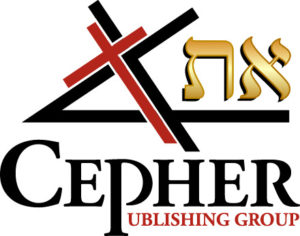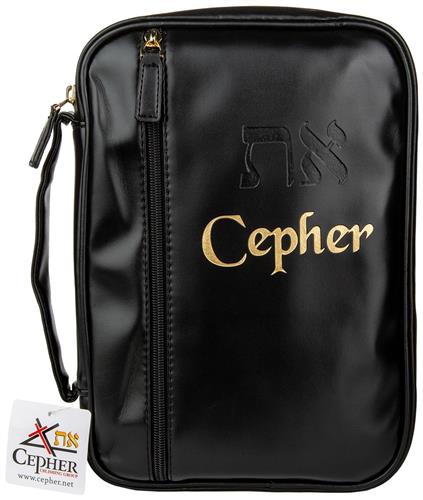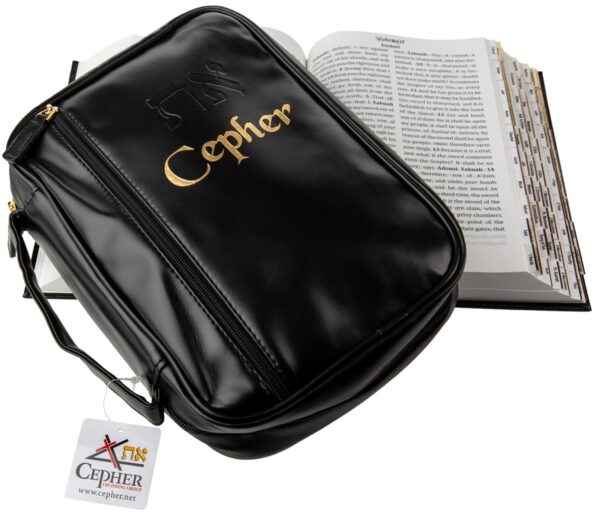The CEPHER Story
 The Cepher Publishing Group is an assembly of believers who have come together to bring the unabridged Word of the Heavenly Father to the world in printed form. In the late 1990s, Stephen Pidgeon, the group’s founder, discovered that many books and other texts were missing from the Bible. For instance, the Bible references the Book of Jasher by name, and well as several other books which have been renamed (such as the Book of Iddo, and the Book of Nathan). In addition, the Septuagint provided an entire series of books that have formerly been included in the Bible, but aren’t anymore.
The Cepher Publishing Group is an assembly of believers who have come together to bring the unabridged Word of the Heavenly Father to the world in printed form. In the late 1990s, Stephen Pidgeon, the group’s founder, discovered that many books and other texts were missing from the Bible. For instance, the Bible references the Book of Jasher by name, and well as several other books which have been renamed (such as the Book of Iddo, and the Book of Nathan). In addition, the Septuagint provided an entire series of books that have formerly been included in the Bible, but aren’t anymore.
Stephen began to read not only the books designated as the Apocrypha, but also other books such as those found in the Dead Sea Scrolls. Early in 2002, he began to compile his own “Bible” for personal use, which also included the Book of Jubilees and the Book of Enoch. In 2006, Stephen and one of his Bible Study partners, Brad Huckins, were sharing information about various editions of the Bible and discussing the accuracy of these translations when they discovered a similar interest in uncovering the essential truth of the scriptures. Late in 2008, Stephen first suggested that the public domain copy of the King James Bible should be modified to minimize the archaic English. This resulted in the first digital file serving as a baseline for the scriptures in the book we now call the את CEPHER.
There were notorious errors in the KJV, and we began to unravel some of these. First, we compared the KJV with the Tyndale Bible which preceded it, allowing us to compare and correct some of the conclusions made by the KJV editors. However, we corrected the New Testament by using the Stephanus Textus Receptus and comparing each term using Strong’s Greek Concordance and other Greek Lexicons, including several Greek Online Dictionaries and the Septuagint. Initially, we used the Hebrew Masoretic text for purposes of cyphering the underlying Hebrew, the Strong’s Hebrew Concordance and other Hebrew Lexicons; however, in the final analysis, we have made reference to over five databases for the Hebrew text (excluding the Dead Sea Scrolls). In addition, we have made comparisons across other English texts (most of which having glaring errors and omissions), and relied upon other Textus Receptus editions, the Latin Vulgate, the Codex Vaticanus, the Shem Tov Hebrew Gospel of Matthew, as well as other source material using state-of-the-art software systems for reference.
As you might imagine, we were simply stunned at what we found. First, the most important names in the Bible had not been translated, or even transliterated. Instead, the names were substituted! We found this alarming, particularly in light of scriptural references being expressed about publishing and declaring the name. This is when we elected to add the sacred name to the text, which was no easy task. We were misled by the Masoretic text and had to reach our own conclusion; however, after testing the sacred name in Israel over a period of two years, we came to conclude that the name is properly pronounced YAHUAH. Once we reached this conclusion, we decided to correctly transliterate all of the other names in the text. This resulted in 3800 name changes! Again, we were stunned at what we learned because all of the names have particular meaning; which reveals so much more!
We corrected some other glaring mistakes. For instance, every English Bible makes a huge error in the Song of Solomon concerning the gender of the speaker which, of course, completely destroys the text. In addition, virtually every English Bible makes reference to “Lucifer” as the “son of the morning.” This reference has confused many believers because the Savior is referred to as the Morning Star. Our review indicates that the name “Lucifer” is not a translation or transliteration, but a substitution, which we deemed to be unacceptable. Additionally, every Bible we have ever seen actually leaves out a word in this passage, and that word means “howling.” In the את CEPHER, there is no confusion between Heylel; son of the howling morning and Yahusha HaMashiach; the Morning Star.
Another glaring error is the genealogy set forth in Matthew 1 is that of Miryam (Mary), it is not the genealogy of her husband Joseph! Count the generations: 14, 14, and 14 – except in every English Bible the last set has 13. This error was easily corrected, once we realized that Joseph (Yoceph) was also the name of her father.
Matthew 23:1-2 has been another continuing error, using the word “they” where the word “he” belongs. Additionally, you can look over the Greek texts for years and never find the word “gentile.” What a misleading term that has become! Paul used the Greek word “ethnos,” which means “other people”, not gentiles.
Another critical substitution has been misleading the world for centuries, and is found in Revelation 13:18. This is the number six hundred three score and six. This number is not a translation or a transliteration, but once again a substitution. This substitution is based on the theory that gematria was practiced by the Greeks (which it wasn’t) and that the numbers reflect the order of the Greek alphabet (which they don’t). The use of 666 is therefore based upon an assumption, founded on error, to render a substitution rather than a translation. In the Cepher, you will find the original source letters in Greek; χξς (pronounced chi, tsi, and stigma).
As we looked over the text, we discovered the Old Testament was incredibly out of order. For instance, Ezra and Nehemiah – books that describe the rebuilding of the second temple and the wall of Jerusalem – are typically placed before the Psalms, which were written before the first temple was constructed. Both Job and Daniel are out of place, and of course, none of it made sense once the books of the Apocrypha were incorporated. Keeping in mind that we transliterated all of the names, including the names of the books of the Bible itself, it became important to find an order that would work.
The decision was made not only to include the books of the Apocrypha (all of which were canonized at the Council of Trent and which were included in the 1611 King James Bible), but also Second Baruch (or the Apocalypse of Baruch), and 3 & 4 Esdras. In addition, we elected to incorporate 3 & 4 Maccabees and the books of Enoch and Jubilees. We believe this decision was warranted given the number of copies found at Qumran in the Dead Sea Scrolls, not to mention the history of the books as part of the canon in Ethiopic and Asyriac texts. Finally, we elected to include the Book of Jasher. We made this decision because of the number of references within the Bible itself, and even the discussion of the facts that can only be found in the Book of Jasher which were made by the Apostle Paul. When you look at the את CEPHER, you will see the names of the books have been changed to their original Hebrew titles. For example, Enoch is Chanok, Jubilees is Yovheliym, and Jasher is Yashar. However, we have left conspicuous road maps to help you find your way throughout the את CEPHER, as every book is also referenced in the names you might recognize even though the order may be completely new to you. Some have asked us why we call this the את CEPHER and not a Bible. The answer is, that the Bible in its entirety is included within the את CEPHER, but so are many other sacred scriptures which we believe are indispensable to the believer. The word cepher is Hebrew for “book”; hence, we are calling this work the Book, as compared to naming it after the pagan city of Biblos.
The New Testament has been the subject of completion as well, although we have not added any books to the 27 identified in the early fourth century as the New Testament. We, of course, no longer distinguish between new and old testaments, but segregate the scriptures much differently; separating the Torah from the Sheniy Cepheriym (second books), the Ketuviym (writings) from the Nevi’iym (Prophets), the Sheniy Heykal (second temple) from the Trei Asar (the twelve), the Besorah (Synoptic Gospels) from the Ma’aseh (Acts), and the Cepheriym Talmidiym (Disciples’ Letters) from the Cepheriym Sha’ul (Paul’s Letters) and the Cepheriym Yahuchanon (John’s Letters). We begin the writings that follow the Messiah with the Synoptic Gospels of Mattithyahu (Matthew), Marcus (Mark) and Lucas (Luke), and this is followed with the Acts of the Apostles called the Ma’aseh. Speaking of the book of Acts, unlike all other English Bibles, we have the completed text of this book, finishing with Chapter 29 (in reliance on the Suninni Manuscript and the Muratorian fragment). We follow this with the Cepheriym of Ya`aqov (James), Kephas (Peter) and Yahudah (Jude). This is then followed by the writings of Sha’ul (Paul) but in two groups: those books actually written by Sha’ul and those books which were written in his name by others; the pseudepigraphal Cepheriym of Sha’ul. Finally, we finish with the Cepheriym Yahuchanon (the writings of John), including his Besorah (gospel), his epistles, and the Book of Chizayon (Revelation).
In 2012, we made an extraordinary discovery, which was the omission of the את(aleph tav) from virtually every English Bible. These two Hebrew letters appear over 7,000 times in the Hebrew text of the Old Testament, yet they receive no interpretation in English. We found these two letters to be indispensable, and so have restored them back into the text. Initially, these were included only in the books of the Tanakh, but when we stood in the courtyard of the church which was constructed over the birth site of Yahuchanon the Immerser (John the Baptist) in Ein Karem, Israel (a suburb of Jerusalem), we discovered the את also appear in the Hebrew New Testament. As such, they are reincorporated over 9,000 times in the את CEPHER.
This journey has been remarkable for us at the Cepher Publishing Group. In 2012, we were joined by other believers who sought to help us bring this project to market, including Sanford & Debbie Staab and David & Penny Castro. We have pored over the text time after time in our mission to compile the best, most complete set of sacred scripture available anywhere.
May you be blessed as you study the את CEPHER.
Stephen Pidgeon J.D., PhD.
President & CEO Cepher Publishing Group, LLC





